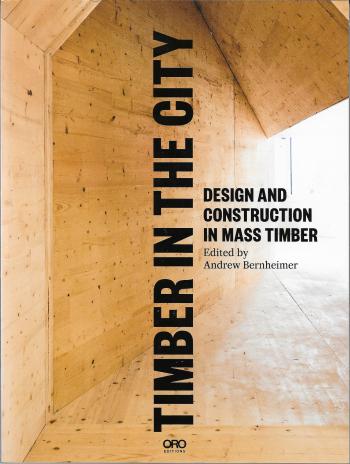Title: Timber in the City: Design and construction in mass timber
Editor: Andrew Bernheimer
Photographer/s: Blouin, Oliver; Boy de la Tour, Didier; De Kan, Peter; Detlor, Owen; Grandorge, David; Delage, Latreille; Lehoux, Nic; Moran, Michael; Müller, Norman A.; Müller, Stefan; Organschi, Alan; Pryce, Will; Tessler, Martin.
Photography courtesy of: Naturally:Wood.
Consulting Editor: Andrea Monfried
Designer: Dungjai Pungauthaikan
Research Assistant: Gizem Sivri
ISBN: 978-1-941806-80-7
Size: 165mm by 219mm, 192p.
Publisher: ORO Editions
Publisher www: www.oroeditions.com

Timber in the City: Design and construction in mass timber is an architectural book that looks at not just the design of a building, but the design of a community. Taking a city block in Brooklyn, the book documents the results of a competition to redesign an underdeveloped site into a combined residential-construction block, with mass timber being a common denominator between the applications. There is an additional section that examines other successful examples of mass timber used in construction from around the world to provide context to this material.
Timber in the City is divided into three sections. The first contains two essays, the first of which is an extremely persuasive presentation on the benefits of mass timber, particularly in the larger scale of city blocks. As a sustainable, prefabrication-friendly material, mass timber is ideal for high-density living. The second of the two essays comes from Waugh Thistleton, an English architectural firm with experience in working with mass timber at a large scale, having built multiple apartment buildings from this material in recent years. The two essays fully support mass timber as a construction material for the 21st century.
The second section is the most exciting of the book: the Red Hook Project. Timber in the City includes seven proposals to revitalise the Red Hook block through job-creation and high-density housing development. Most of the proposals combine these two goals closely, first building construction facilities that then create the housing for those working within. There is also a heavy focus on creating a more natural living environment for the community, bringing trees and water into the site and encouraging sustainable living. The award for the best proposal was awarded to the ‘Grow Your Own City’ project from the University of Oregon. This project stood out due mainly to a long arching vision, creating a community that supports itself and, once established, can reach out into the wider world to generate growth by creating the building blocks for future communities. This and each of the six other proposals contain very inspiring ideas that have the potential to shape the way our cities are shaped.
The third section of the book comprises of a number of case studies examining uses of mass timber. All of the examples are at the most seven years old and show how the technology and materials are being used today. These buildings often have quite experimental elements within them and include multiple photos and architectural diagrams showing the structure and connections used. There is a large variety in the purposes of each of the buildings, from residential to sport complexes to commercial structures, showing the flexibility of mass timber. Some of the most engaging of these projects are Tamedia from Shigeru Ban Architects (109), with its enormous circular wood connectors visible through a glass building skin, the Sneek Bridge from ONIX AchterboschZantman Kunstwerke (161), a picturesque raking form that enlivens the typical solid concrete of an overpass, or the Four Corners pavilion by Ultramoderne (185), an arresting combination of folding forms. These examples show the potential of mass timber as architects move away from more energy-intensive materials.
Timber in the City makes a strong case for the benefits of mass timber in an urban context. From the multiple approaches to the Red Hook revitalisation to the various projects examined in the latter half of the book, mass timber is shown to be applicable in almost any situation. This book also shows how mass timber is superior to the ubiquitous steel and concrete in many ways, and shows how mass timber could be used in the future as the major construction material. While Timber in the City is a small book, lacking the large photos and high-gloss pages of a book bound for the coffee table, it makes up for it in the potency of its ideas and is well worth exploring for these innovative concepts.
